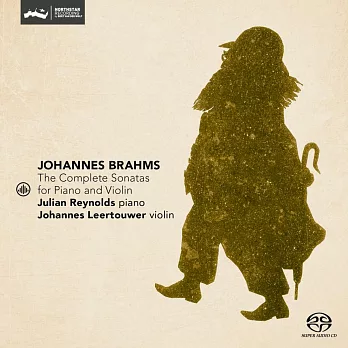這是荷蘭著名的小提琴家兼指揮家Johannes Leertouwer全新錄製的一份布拉姆斯小提琴奏鳴曲全集錄音.留聲機雜誌提到: "Reynolds get top billing - these are sonatas for piano and violin, after all - and he phrases throughout with great sensitivity. In his recording with Julius Katchen (Decca, 1/68), Suk uses portamento with such discretion that you hardly notice it. I find that preferable; but Reynolds and Leertouwer, beautifully recorded, are well worth hearing."
非常值得一聽的一份充滿新意的布拉姆斯全集錄音
We made this recording in January 2023, one week before I defended my dissertation on historically informed performance practice of Brahms’s orchestral music at Leiden University and received my doctorate. The research had offered me the opportunity to re-investigate my ideas about contemporary performance style, particularly of 18th- and 19th-century repertoire. Over the course of the 4-year project, I had rehearsed, performed, and recorded the Brahms symphonies and concertos as a conductor. After so much reading, writing, and conducting, I found that I longed for the experience of applying what I had discovered as a violinist to find how it had changed my approach to Brahms’s chamber music. I called Julian Reynolds and asked if he would be willing to experiment with my findings. We had studied the Brahms violin sonatas together with Josef Suk in Vienna and Prague many years ago. We found a beautiful Blüthner grand piano of 1857 in the atelier of Andriessen pianos in Haarlem.
Our recording represents our desire to find the freedom to apply the 19th-century expressive tools of flexibility of rhythm and tempo, of expressive legato, portamento and vibrato that have been largely forgotten or perhaps discarded over the course of last century. These tools cannot simply be dusted off and re-implemented. As I argued in my dissertation, working with them requires re-inventing them. Portamento for example was a hotly debated subject throughout the 19th century. There is no single model or example of how to apply it today. The same can be said about vibrato. What we can say with certainty is that in the violin methods of Louis Spohr and later Joseph Joachim and Andreas Moser, portamento was named as the first and most important means of expression for string players, and vibrato was described as an ornament. When it comes to flexibility of tempo, we can be sure that the 19th-century concept of tempo was more flexible, and that modifications of tempo were much more frequent than in more modern times. We know that Brahms had a particularly free and flexible way of performing his own music. Brahms himself famously refused to give metronome markings, writing that he could not find a meaningful relationship between his flesh and blood and such a mechanical instrument, a feeling perhaps inherited from Beethoven. He also wrote that any “sane musician” would take a different tempo every week.
本專輯為雙層SACD,可於一般CD player中播放.
曲目:
Brahms:
Violin Sonata No. 1, Op. 78 in G Major
Violin Sonata No. 2, Op. 100 in A Major
Violin Sonata No. 3, Op. 108 in D Minor
Johannes Leertouwer (violin)
Julian Reynolds (piano)
